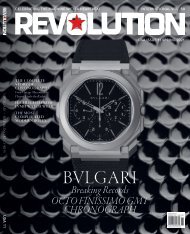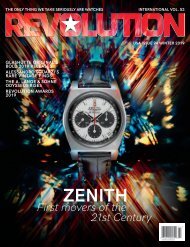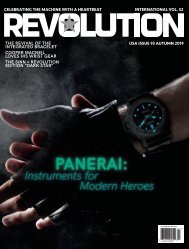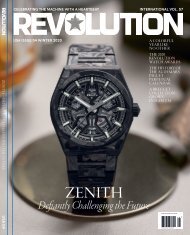Create successful ePaper yourself
Turn your PDF publications into a flip-book with our unique Google optimized e-Paper software.
LVMH WATCH WEEK DUBAI<br />
MADE OF STARDUST<br />
Hublot’s Classic Fusion Gold Crystal<br />
recreates one of the world’s rarest forms<br />
of the precious metal.<br />
WORDS DARREN HO<br />
HUBLOT<br />
CLASSIC FUSION GOLD CRYSTAL<br />
MOVEMENT Self-winding HUB1112 movement; hours,<br />
minutes and seconds; 4Hz; 42-hour power reserve<br />
CASE 45mm in polished and satin-finished black ceramic;<br />
ceramic bezel with titanium screws; polished black dial with<br />
24K gold crystals; water resistant to 50m<br />
STRAP Black alligator leather strap with rubber back; blackplated<br />
stainless steel deployant clasp<br />
Gold is one of the rarest metals in the world, its beauty<br />
admired across the globe and cultures that span the entire<br />
of documented human history. In fact, all the gold you see<br />
today is truly stardust, the result of a cosmic collision of black holes or<br />
neutron stars that smashed into each other. These powerful collisions<br />
generated the energy needed to bind lighter elements into heavier<br />
ones in a matter of seconds. Scientists speculate that such a collision<br />
occurred billions of years in the past in our solar system’s vicinity. That<br />
same collision likely resulted in the very birth of our solar system.<br />
Most of the gold found in the crust and mantle of the Earth<br />
are microscopic dust particles embedded in rock; far less is<br />
actually in nuggets found in bedrock or mines. But of all the<br />
variations of gold that one sees in the natural world, the rarest is<br />
crystalline gold. The material is formed as gold-bearing water<br />
runs through rock, forming veins upon which the gold flakes are<br />
deposited. (The largest ever discovered single crystal of gold found<br />
was 217 grams in weight, and worth over USD1.5 million.)<br />
At the Hublot manufacture’s research and development<br />
department, they discovered how to replicate such crystalline<br />
forms of gold by heating pure gold to 1,947°F, which melts<br />
the material and that rises until it encounters a cooler<br />
environment, when it then crystallizes. If you recall old<br />
chemistry classes on distillation, it’s not unlike that.<br />
Since the crystals never form in exactly the same manner or form,<br />
you never quite get the same shape or style. At Hublot, a dial maker<br />
carefully collects these flakes and arranges them on a dial to re-create<br />
the auriferous veins that one would see in nature, then coated with a<br />
clear lacquer that seals the flakes in position. This is done over and over,<br />
until the gold is perfectly displayed on the deep black dial of the watch.<br />
The recreation of the natural beauty of gold crystals is part of the<br />
allure of this watch, particularly housed in a high-tech ceramic case.<br />
It’s a great case of technology imitating nature.<br />
THE MODERNIST 57











